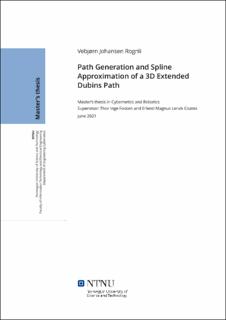| dc.contributor.advisor | Fossen, Thor Inge | |
| dc.contributor.advisor | Coates, Erlend Magnus Lervik | |
| dc.contributor.author | Rognli, Vebjørn Johansen | |
| dc.date.accessioned | 2021-09-23T19:04:24Z | |
| dc.date.available | 2021-09-23T19:04:24Z | |
| dc.date.issued | 2021 | |
| dc.identifier | no.ntnu:inspera:76427839:26479704 | |
| dc.identifier.uri | https://hdl.handle.net/11250/2781100 | |
| dc.description.abstract | En viktig egenskap som muliggjør autonom flygning av ubemannede fartøy (UAV) er automatisk baneplanlegging. Dette arbeidet tar for seg problemet med å generere en tredimensjonal bane, fra en sekvens av veipunkter, som tar hensyn til de dynamiske begrensningene som gjelder for små ubemannede fly.
En hensiktsmessig bane for et lite ubemannet fly er en bane med kontinuerlige foroverkoblingssignaler for rullvinkelen, stampvinkelen og girvinkelen. Metodene for todimensjonal banegenerering er basert på den klassiske Dubins banen og den kurvatur kontinuerlige Extended Dubins banen, men metodene er generaliserte til en sekvens av veipunkter. Metodene er basert på eksisterende arbeid, men endret for å være mer beregningseffektive, ved blant annet å unngå numerisk integrasjon, og forbedret i visse spesielle tilfeller som ikke var tatt hensyn til originalt. Den tredimensjonale banegenereringen dekobles i en horisontal banegenerering og en vertikal banegenerering. Den horisontale banen og den vertikale banen generes med to forskjellige metoder siden graden av kontinuitet som er nødvendig i horisontalplanet og i vertikalplanet er forskjellig for å få en hensiktsmessig bane. Den resulterende tredimensjonale banen approksimeres med kubisk algebraiske spliner for å få en uniform parameterfremstilling av banen, som forenkler gaiding, og for å forbedre beregningseffektiviteten siden numerisk løsning av integraler under gaiding unngås. | |
| dc.description.abstract | A key ability of autonomous flight for fixed-wing unmanned aerial vehicles (UAVs) is the ability to plan flights automatically. This thesis treats the problem of generating a three-dimensional path, from a sequence of waypoints, that is feasible with respect to the dynamic constraints of fixed-wing UAVs. A feasible path for a fixed-wing UAV is a path with continuous feedforward signals for the roll angle, the pitch angle, and the heading angle. The two-dimensional path generation methods in this thesis are inspired by the classical Dubins Path and the curvature continuous Extended Dubins Path, but the methods are generalized to a sequence of waypoints. The methods are based on existing work but modified for efficient computation, such as avoiding numerical integration, and improved in certain edge cases. The three-dimensional path generation is decoupled into horizontal path generation and vertical path generation. The horizontal path and vertical path are generated with two different methods since different levels of continuity are required in the horizontal plane and the vertical plane for a feasible path. The resulting three-dimensional path is approximated by cubic algebraic splines for a unified path representation which simplifies guidance and improves computational efficiency since numerical integration during guidance is avoided. | |
| dc.language | eng | |
| dc.publisher | NTNU | |
| dc.title | Path Generation and Spline Approximation of a 3D Extended Dubins Path | |
| dc.type | Master thesis | |
